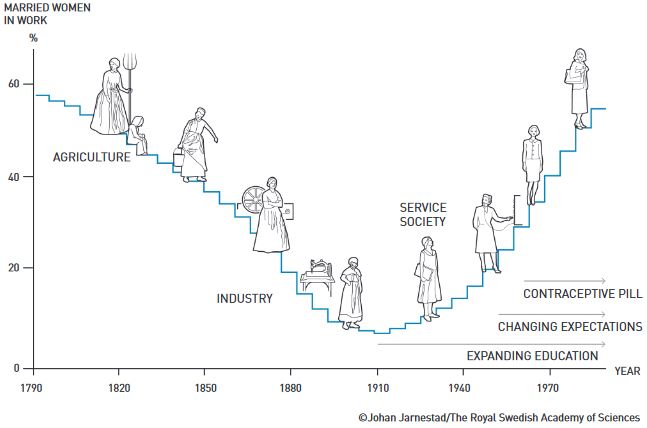
Economists & Prizes
2023 Nobel Prize in Economics - The Winner
Read a summary using the INOMICS AI tool
The famous 2023 Sveriges Riksbank Prize in Economic Sciences in Memory of Alfred Nobel, colloquially known as the Nobel Prize in Economics, has been awarded to a Harvard University economist this year: Dr. Claudia Goldin. The prize – worth 11 million Swedish crowns, or about $1 million or roughly €949.000 – was awarded to her by the Royal Swedish Academy of Sciences “for having advanced our understanding of women’s labour market outcomes…Her research reveals the causes of change, as well as the main sources of the remaining gender gap.”1
Receiving this prize makes Claudia Goldin only the third woman to win the Nobel Prize in Economic Sciences (following Elinor Ostrom in 2009 and Esther Duflo in 2019), and makes her the first to do so alone, i.e. without sharing the prize with another economist.
The research that awarded the prize
The research that won Dr. Goldin the Nobel Prize examines the gender pay gap between men and women through the centuries. To start, Dr. Goldin gathered U.S. data across the past 200 years. She analyzed this data to look for trends in employment and earnings for both men and women to study how the gender pay gap evolved – and to explain why it still exists today. Part of the reason for her Prize is that this information can help society to fight the gender pay gap, ensuring that equally qualified men and women are paid the same amount.
According to the Royal Swedish Academy’s press release1, Chair of the Committee for the Prize in Economic Sciences Jakob Svensson had this to say about Dr. Goldin’s research:
“Understanding women’s role in the labour market is important for society. Thanks to Claudia Goldin’s groundbreaking research we now know much more about the underlying factors and which barriers may need to be addressed in the future.”
A few of Dr. Goldin’s findings stand out. First, the participation of women in the workforce has evolved over time in a roughly U-shaped pattern (see Figure 1, which was illustrated by Johan Jarnestad for the Nobel Prize organization). A few centuries ago, before the Industrial Revolution – when society was more agrarian – women participated in the labor force at a rate of almost 60%.

Figure 1: women’s workforce participation since the late 1700s
During the decades from the late eighteenth century through the start of the twentieth, women’s workforce participation steadily declined as society industrialized. Then, in the early twentieth century, it started to rise again.
Dr. Goldin postulates that several factors gave rise to this resurging increase in women’s workforce participation. First, educational attainment for women began to climb in the twentieth century. That trend in particular has continued; in the present day, the majority of college degrees are now earned by women rather than men in most western nations, including the U.S3.
Changing social expectations aided the increase in workforce participation, too. Around the 1960s, cultural expectations about a woman’s role in the family became less strictly about motherhood and child-rearing5. Dr. Goldin theorizes that younger women began to expect less and less that they needed to devote their lives to managing a household and raising a family first, as their mothers did. This enabled women to tackle their career without as much stigma (although that’s not to say these expectations have ceased to be an issue for women in the workforce in many countries today).
Another factor that enabled women’s participation in the post-industrial workforce to rise again was better access to contraceptives, particularly “the pill”. This gave women more power to choose when and if to become mothers, which can potentially put their careers on hold, traditionally significantly more so than for men.
Detailing the gender pay gap
Yet, despite increasing educational attainment and workforce participation, men still earn more than women on average, even when they are of the same skill and experience level as their female counterparts.
Dr. Goldin finds that although the pay gap for men and women can be explained to a large extent (at least historically) by educational attainment and career choice, the modern gap is more complicated. Even between men and women in the same career field, the pay gap widens significantly once a woman has her first child. From that point on, the earnings gap between men and women remains throughout the rest of their careers.
The Pew Research Center additionally finds that the gender pay gap in the US has remained mostly unchanged for the past twenty years. The data shows that in the US, women earn roughly 82% of what an experience-equivalent man would earn on average.
Last year, INOMICS Salary Survey data showed that on average in economics careers, male economists are paid 23.1% more than female economists. This figure remained remarkably stable at roughly 20% for men and women with a Master’s degree, and also men and women with a PhD. The pay gap varies significantly by employer type within economics, however; the worst offenders according to the 2022 data are private employers, with an average pay gap of 35%. Universities and governments exhibited a gender pay gap of again roughly 20%.
Dr. Claudia Goldin: Bio
Labor economist and economic historian Dr. Claudia Goldin was born in 1946 in New York, NY, USA. She received her BA in economics from Cornell University, after originally intending to study microbiology. She received her PhD in economics from the University of Chicago in 1972.
After receiving her PhD, Dr. Goldin began to teach; she taught at various universities including Princeton before being offered tenure at Harvard in 1990. Another first: she was the first woman to be offered tenure in Harvard’s economics department.
She became an editor for the Journal of Economic History from 1984 until 1988. She served as the president of the Economic History Association and the American Economic Association in 1999 to 2000 and 2013 to 2014, respectively. She is a member of the National Academy of Sciences and the American Philosophical Society, and was elected a fellow of the American Academy of Political and Social Science, the Society of Labor Economists, the Cliometric Society, the Econometric Society, and the American Academy of Arts and Sciences.
Dr. Goldin is also the author of many successful books, including Understanding the Gender Gap: An Economic History of American Women, a book that details some of her research on the topic that won her the Nobel Prize. She has supplemented this book with further research on topics like the impact of the contraceptive pill on women’s career decisions, the usage of woman’s surnames after marriage, and the fact that women have become the majority of undergraduate degree earners.
Previous to her Nobel Prize award, Dr. Goldin has been the recipient of many awards and accolades, including (but not limited to):
- the Richard A. Lester Award for the Outstanding Book in Industrial Relations and Labor Economics in 1990, 2008, and 2021
- the American Economic Association’s Carolyn Shaw Bell Award in 2005
- the 2009 Mincer Prize for her labor economics contributions
- the IZA Prize in Labor Economics in 2016
- the 2019 BBVA Frontiers in Knowledge award in economics
- the 2020 Nemmers award in economics
You can read the full Nobel Prize in Economic Sciences press release at the Royal Swedish Academy of Sciences’ webpage.
References
1: https://www.nobelprize.org/prizes/economic-sciences/2023/press-release/
2: https://scholar.harvard.edu/goldin/biocv
3: https://www.kva.se/en/news/the-prize-in-economic-sciences-2023/
4: https://www.richmondfed.org/publications/research/econ_focus/2014/q4/interview
5: https://www.usnews.com/news/articles/2010/03/12/the-1960s-a-decade-of-change-for-women
The "Married Women in Work" graph is a copyrighted image produced by Johan Jarnestad for the Royal Swedish Academy of Sciences.
Header image credit: Pixabay.
-
- Conference
- Posted 1 week ago
EcoMod2026 International Conference on Economic Modeling and Data Science
Between 8 Jul and 10 Jul in Esch-sur-Alzette, Luxembourg
-
- Online Course
- (Online)
- Posted 1 week ago
Python and Statistics for Financial Analysis
at Hong Kong University of Science and Technology and Coursera in Hong Kong SAR China
-
- PhD Program
- Posted 3 days ago
Graduate Program in Economics and Finance (GPEF) - Fully funded Ph.D. Positions
Starts 1 Sep at University of St.Gallen in Sankt Gallen, Switzerland















